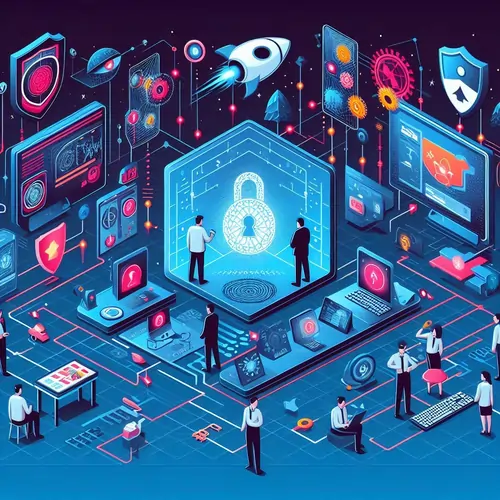- Essential Networking Tools Every Student Should Know
- Julia Evans' Networking Toolset
- Post-Quantum Cryptography: Securing the Future of the Internet
- The Quantum Threat
- NIST and Standardization
- Real-World Use of PQC
- Observing TCP Behavior at a Massive Scale
- A Real-World Case: Cloudflare’s Observations
- The Mystery of Transient DNS Domain Names
- What Are Transient Domains?
- IP Geolocation and Its Real-World Applications
- Traditional Approaches
- A Better Solution: RFC 9632
- The Digital Divide: Not Everyone Has Internet Access
- Key Efforts Toward Inclusion
- Empowering Networking Students: Why Exploration Matters
- Final Thoughts
We’re not just focused on completing assignments—we’re dedicated to empowering students with the knowledge and tools needed to thrive in the evolving field of networking. In this blog, we explore key concepts that every networking student should grasp, including powerful networking tools, the emergence of post-quantum cryptography, transient DNS domain behavior, and the complexities of IP geolocation. These topics go beyond theoretical understanding and dive into real-world applications that can shape your academic and professional journey. Whether you're trying to interpret TCP resets observed in large CDNs or explore how TLS is being secured with post-quantum algorithms, these insights offer valuable learning opportunities. For those looking for computer network assignment help, this blog is a valuable resource that bridges academic knowledge with practical application. If you're working on projects that require deeper analysis of network behavior—especially tasks that involve understanding TCP connections or packet resets—our experts also provide help with TCP assignment to ensure you understand every aspect of connection behavior and protocol performance. This post is part of our ongoing effort to support students with timely, relevant, and actionable content designed to simplify even the most complex networking topics.
Essential Networking Tools Every Student Should Know
Understanding network protocols is foundational, but being able to use networking tools efficiently is just as important. These tools are invaluable for diagnosing problems, capturing packets, analyzing traffic, and understanding how data moves across networks.

Julia Evans' Networking Toolset
One standout contributor to the networking education space is Julia Evans, well-known for her engaging "Wizard Zines" and insightful posters. She has compiled a handy poster that lists some of the most essential networking tools used in real-world environments.
Some of the tools featured include:
- Wireshark: For capturing and analyzing packets.
- tcpdump: A command-line packet analyzer.
- netcat (nc): A versatile networking utility.
- traceroute: To track packet routes across networks.
- dig and nslookup: Useful for DNS diagnostics.
- curl and wget: For testing web protocols and endpoints.
- iftop and nethogs: For real-time traffic monitoring.
Mastering these tools provides a practical edge for any student tackling computer networking assignments or preparing for industry roles. At computernetworkassignmenthelp.com, our experts can guide you in using these tools for your coursework, lab exercises, and capstone projects. Whether it’s packet capture or traffic simulation, we help simplify the process.
Post-Quantum Cryptography: Securing the Future of the Internet
Today’s secure communication protocols like SSH and TLS 1.3 rely on algorithms such as RSA, AES, and ChaCha. These algorithms have withstood the test of time—until now.
The Quantum Threat
With the rise of quantum computing, traditional encryption is at risk. Quantum machines could potentially break RSA and ECC-based encryption, making it imperative to transition to Post-Quantum Cryptography (PQC).
NIST and Standardization
The National Institute of Standards and Technology (NIST) launched a global initiative to standardize quantum-resistant algorithms. After a rigorous multi-year evaluation, three new algorithms have been officially standardized, and a fourth is on the way.
Real-World Use of PQC
Some organizations have already started adopting PQC within TLS sessions. If you're curious whether a website uses post-quantum security, try the pqspy Firefox addon—a free and open-source tool on GitHub.
As a student, learning about these modern cryptographic protocols and their application in real-world environments is key. Our team at computernetworkassignmenthelp.com can provide guidance on implementing or analyzing post-quantum cryptography in networking assignments.
Observing TCP Behavior at a Massive Scale
The Transmission Control Protocol (TCP) is one of the foundational protocols of the Internet. It manages the flow of data between devices and ensures reliable delivery.
A Real-World Case: Cloudflare’s Observations
Cloudflare, one of the world’s largest Content Delivery Networks (CDNs), handles over 60 million HTTP requests per second. Not all these requests come from humans—some are automated, some malicious, and others anomalous.
Cloudflare’s deep-dive into TCP RST (Reset) packets provides an extraordinary look into the unexpected behaviors that occur across global networks. These RST packets, which indicate abrupt connection closures, reveal:
- Rogue or misconfigured clients
- Security appliances causing resets
- Botnet traffic or scraping attempts
- Anomalies from IoT devices
Their analysis highlights the value of large-scale measurement in improving protocol robustness and understanding how the Internet works under real traffic conditions.
Students often overlook TCP behavior at scale—but this is a goldmine for research and advanced coursework. If you're tackling TCP-related assignments, our experts at computernetworkassignmenthelp.com can help you make sense of these complex behaviors and even replicate some of Cloudflare's observations using lab simulations.
The Mystery of Transient DNS Domain Names
DNS (Domain Name System) is essential for resolving human-readable domain names into IP addresses. However, the domain name system is also a playground for cybercriminals and experimental behavior.
What Are Transient Domains?
An intriguing research study tracked domain names that were registered and unregistered within 24 hours. These are called transient domains.
Key findings include:
- 20,000+ transient domains were observed in January 2024 alone.
- Some are the result of typos or test cases.
- Many are likely tied to fraudulent, phishing, or spam activities.
Transient domains are difficult to trace and often used in cyberattacks, which makes them a hot topic in cybersecurity and network forensics.
If you're exploring DNS, cybersecurity, or Internet measurement projects, this topic offers rich ground for discovery. At computernetworkassignmenthelp.com, we help students explore DNS behavior, detect anomalies, and develop smart analysis scripts for academic or real-world scenarios.
IP Geolocation and Its Real-World Applications
IP Geolocation refers to mapping an IP address to a physical location. This is vital for:
- Serving location-specific content
- Enforcing content restrictions
- Fraud prevention
- Ad targeting
However, the Internet wasn’t designed with geolocation in mind, which makes accurate mapping difficult.
Traditional Approaches
- WHOIS Data: Often maps IP addresses to ISP headquarters, not end-users.
- Commercial Databases: Proprietary, sometimes inaccurate.
A Better Solution: RFC 9632
To address the limitations, the IETF proposed RFC 9632, which enables ISPs and enterprises to publish accurate geolocation data for IP prefixes.
As of now:
- Nearly 300,000 IP prefixes are already covered.
- The database can be explored through geolocatemuch.com, a public portal.
Geolocation has wide-ranging academic and industry applications. If you’re working on a geolocation project or building a location-aware application, our team can guide you through techniques for improving accuracy and integrating such databases effectively.
The Digital Divide: Not Everyone Has Internet Access
As we analyze advanced protocols and tools, it’s easy to forget that over 3 billion people still lack Internet access. This glaring digital divide is a reminder of the inequities that persist in today’s world.
Key Efforts Toward Inclusion
- GSMA is promoting low-cost smartphones and extending mobile coverage in underserved areas.
- The Internet Society supports initiatives to bring connectivity to remote and rural communities.
For networking students, it’s important to remember the social and humanitarian aspects of the Internet. How can we design networks that are inclusive, affordable, and sustainable? These questions are just as critical as mastering protocols and tools.
Empowering Networking Students: Why Exploration Matters
This blog post was inspired by the open-access Computer Networking: Principles, Protocols, and Practice (CNP3) ebook—a fantastic resource that encourages curiosity and exploration.
Whether you're just starting out or are already deep into protocol analysis and network simulations, there’s always something new to learn.
Our goal at computernetworkassignmenthelp.com is to support that journey. From assignments and lab reports to dissertations and live projects, our team of computer network assignment help experts can guide you through:
- Protocol simulations
- Tool-based diagnostics
- Security protocol analysis
- Emerging technology integrations (e.g., post-quantum cryptography)
We invite students to go beyond textbook learning and embrace experimentation, creativity, and real-world application.
Final Thoughts
The world of computer networking is vast, dynamic, and full of fascinating problems waiting to be explored. From hands-on tools to theoretical breakthroughs, from the rise of quantum-safe algorithms to the global digital divide, there’s no shortage of topics for students to dive into.
If you're working on a networking project, struggling with a tough assignment, or simply want to expand your knowledge, don’t hesitate to reach out to us at computernetworkassignmenthelp.com. We’re here to help you turn challenges into opportunities and assignments into achievements.
